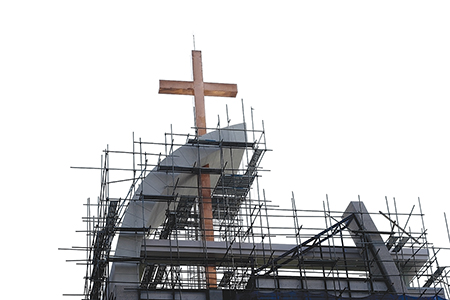
Satellite locations and church growth
In recent years, the launching of congregational outposts — also known as satellite locations — has become a popular strategy for relieving the pressure of growing attendance on a “main site,” or for stretching the borders of the religious institution’s tent by expanding into a burgeoning suburban community.
Historically, religious institutions tended to try to grow at a single location by implementing a multi-phase masterplan whereby early growth was housed in one or more structures in a single location which could later be converted to classrooms or offices after congregational growth leveled off and better defined the needed size of the final structure: the worship center.
Lenders have grown comfortable, however, with the multi-location approach, due, in part, to its scalability. From a risk manager’s perspective, if the religious institutions were to face financial challenges due to either an economic downturn or a leadership transition, having one large mortgage payment presents fewer options than two smaller ones. A decline in contributions could be offset by the closure of a satellite location.
Nevertheless, while lenders are generally comfortable with the satellite trend, there are several dos-and-don’ts which your religious institutions leadership team should be aware of in order to secure the long-term support of a financial partner.
Leasing a facility

When adding a new worship location, the most common and fiscally prudent approach is to begin by leasing a facility. Starting with a relatively smaller space enables the parent organization to limit its start-up costs and potential impact to consolidated cash flow. The lease duration should also be short enough to accommodate a subsequent relocation if growth should warrant, yet long enough to justify the dollar cost of tenant improvements required for ministry use.
There are no set rules in this regard; however, lenders are unlikely to be receptive to a plan to make a multimillion-dollar investment in tenant improvements to a facility with a short-term (12– to 24-month) lease. Depending upon the age and stability of the satellite congregation, the inclusion of an option to purchase might mitigate this concern.
Tracking attendance
Once the satellite matures to a state of steady worship attendance and contributions, the lender will likely entertain a request to purchase or build a facility for the satellite congregation. Conversely, you can expect that your lender will be reluctant to make a $5 million loan to buy or build a facility for a startup satellite at a location where you have no track record of attendance.
Operating multiple leased satellite locations in various stages of maturity is not uncommon; however, the ratio of attendance at leased locations versus owned sites can cause your lender concern. If your religious institution has one mortgaged location and five leased locations, and only 50 percent of your total institution’s revenue is being generated at the lender’s collateral site, the lender might feel that (depending upon the duration of the leases) the religious institution’s consolidated cash flow is excessively vulnerable to facilities which it does not control.
Also, in a worst-case default and potential foreclosure scenario, the lender might wonder how hard the religious institution will work to retain ownership of the mortgaged facility. If a majority of contributions are collected at leased facilities, the lender might fear the borrower could easily walk away from the mortgaged property. In my experience, lenders will be more likely to support your satellite expansion plan if they know 70 percent or more of your contributions are being collected at owned facilities which are part of the lender’s collateral pool.
Merging with smaller ministries
Another recent trend is satellite expansion by way of merger. Since the economic downturn, many larger financially stable congregations have been approached by smaller faltering ministries in need of rescue. This can present a win-win opportunity.
The merger is often effected by rolling the assets of one entity into the other and then dissolving the smaller corporate entity. In other instances, two corporate entities continue under a common name and pulpit leadership.
In either case, if the ministry which you are taking under your wing has debt, be sure to discuss your plan with your lender prior to moving forward with the merger. Your attorney might tell you that retaining separate corporate entities will shield the parent organization from the liabilities of the smaller ministry. While this might be legally correct, your lender might have other concerns.
Regardless of the corporate distinctions, the lender realizes that the surrounding communities will view the two organizations as one with a single spiritual leader. Consequently, if the smaller congregation struggles with its debt, the parent entity might be compelled to assume the burden of financial subsidy in order to avoid reputation risk.
In a worst-case scenario, if the satellite church defaults and another lender forecloses on the building, the local media will likely associate your good name with the foreclosure. Should this occur, your lender will be concerned about your congregation’s perception of the event and a potential decline in your congregation’s confidence in your leadership, along with their financial contributions. In spite of your best efforts to explain the technical separation between the two legal entities, some percentage of your donors might not understand the nuances and might be reluctant to “throw good money after bad.”
Satellite ministry expansion is clearly a trend which is gathering momentum. Experienced lenders with a track record of funding religious institutions can sit down with your leadership team and define the dos-and-don’ts of satellite expansion. Broaching this topic early with your lender can only be beneficial to your religious institution and help ensure a rewarding relationship with your financial partner.
Dan Mikes is Executive Vice President and National Manager of the Religious Institution Division, Bank of the West, San Ramon, CA.
The views and opinions expressed in this article are those of the author and do not necessarily reflect the official policy or position of Bank of the West.
This article originally appeared in inSight, a professional journal of The Church Network. Reprinted with permission. ©2014 The Church Network
The Church Network: (800) 898-8085


